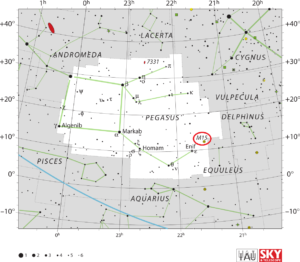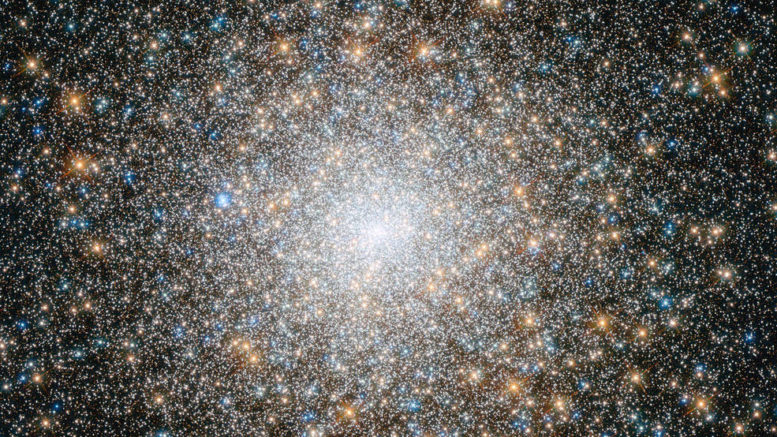With over 100,000 stars and an age of 12 billion years old, Messier 15 the Great Pegasus Cluster is a magnificent sight to see. This globular cluster is one of the densest ever discovered, with very hot blue stars and cooler orange stars becoming more concentrated toward its bright core. Messier 15 is also one of the oldest known globulars in our galaxy. It has an estimated age of 12 billion years and only 1 percent of the Sun’s iron content.
M15 was the first globular cluster known to host a planetary nebula (the gaseous shell of a dying star). This nebula, Pease 1, was detected in 1928 by Francis G. Pease and is one of only four planetary nebulas known to exist within a globular cluster. This cluster has also been found to host a rare type of black hole at its center: an intermediate-mass black hole.
| Description | |
| Visible From Pacific Northwest | May to November |
| Best Time To Observe | October |
| Minimum Size Of Viewing Device | Binoculars |
| Object Type | Globular Cluster |
| Designations | Messier 15, M15, NGC 7078, GCl 120, C 2127+119, MWSC 3518 |
| Right Ascension | 21h 29m 58.33s |
| Declination | +12°10’01.2” |
| Constellation | Pegasus |
| Absolute magnitude | -9.2 |
| Apparent magnitude | +6.2 |
| Apparent dimensions | 18′ |
| Object Radius | 88 light years |
| Distance From Earth | 33,600 light years |
History
M15 was discovered by Jean-Dominique Maraldi on September 7, 1746 while he was looking for a comet.
Charles Messier included the object in his catalogue on June 3, 1764. Believing that it was a nebula, he noted:
In the night of June 3 to 4, 1764, I have discovered a nebula between the head of Pegasus & that of Equuleus it is round, its diameter is about 3 minutes of arc, the center is brilliant, I have not distinguished any star; having examined it with a Gregorian telescope which magnifies 104 times, it had little elevated over the horizon, & maybe that observed at a greater elevation one can perceive stars: I have compared it with the star Delta Equulei; its right ascension has been concluded at 319d 40′ 19″, & its declination at 10d 40′ 3″ north. I have also marked that nebula in the chart of the apparent path of the Comet of 1764.
Johann Elert Bode, who observed the cluster a decade later, could not make out any stars in it either and also described M15 as a “small nebula.”
It was William Herschel who finally resolved the cluster into individual stars in 1783. He observed it in a 10-foot telescope on November 23, 1805.
Locating M15 In The Sky
Surprisingly enough, globular cluster M15 is easy to find. Once you’ve located the “Great Square” of Pegasus, simply choose its brightest and southwesternmost star – Alpha. Now identify the small, kite shape of the constellation of Delphinus. Roughly halfway between these two (and slightly south), you’ll spy a slightly reddish star – Epsilon Peg (Enif).
By placing Enif in your binoculars or image correct finderscope at the 7:00 position, you can’t miss this bright, compact globular cluster.

Viewing M15
Messier 15 can easily be seen in binoculars and small telescopes, but only appears as a fuzzy patch of light in smaller instruments, Even the smallest of optics will reveal the round glow and telescopes starting at 4″ will begin resolution, whereas the cluster’s stars can be resolved by 6-inch and larger telescopes. Amateur telescopes will reveal an object about 7 arc minutes in size visually.
Photographing M15
There are some nice places for amateur astrophotographers to utilize when imaging M15, the Great Pegasus Cluster in the sky. A DSLR can be utilized, but a CMOS camera might provide a better result. Regardless of photographic imaging platform, it is important to note that something as simple as a 7 inch telescope, with tracking and a camera can obtain images. Using. ISO of 3200 on some camera and around 15 and 13 second subframes. Some have used 12 x 90 sec exposures at iso 1600 with 40 darks, and 40 bias photos. Regardless of how it is done because of the individual setup, there are a plethora oof ways to image M15 in the northern skies.
Sources And Further Reading
Descriptions of all of Messier Objects can be found here.
https://www.nasa.gov/feature/goddard/2017/messier-15
https://www.cloudynights.com/topic/633627-messier-15-m15-ngc7078-pegasus/
https://www.mikesastrophotos.com/stars/globular-star-cluster-messier-15/

Be the first to comment on "Messier 15 Great Pegasus Cluster"